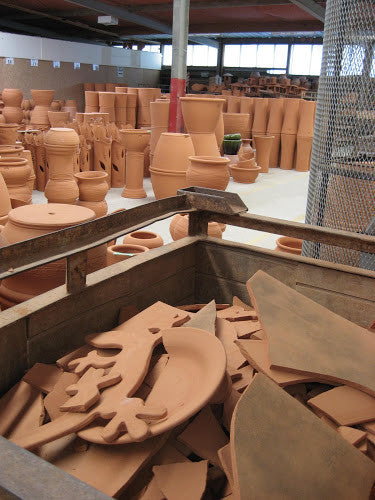
Clay is a ‘living’ material, affected by the environment and in particular atmospheric conditions. In practical terms a large part of our recent success has been in managing the temperamental qualities of our local Matakana clay, a material that is not always a willing partner in the process.

Clay is formed over millennia from a combination of circumstances, and the Northland landscape reflects aspects of this. The topography has been shaped by volcanic activity and cycles of erosion caused by numerous ice ages. An appropriate mix of minerals and an abundant supply of green matter settling in slower moving waterways has seen numerous clay deposits form throughout the region. Of varying character not all local clay is immediately suitable for pottery, and it has taken us many years to achieve a consistent, reasonably compliant material to work with.

Clay is by definition ‘sticky stuff’ but its propensity to hold water can be a challenge. Our clay has a greater proportion of montmorillonite and halloysite minerals than it does kaolinite. The latter being the major ingredient in China Clay, is a soft usually white mineral produced by the chemical weathering of minerals like feldspar. What makes China Clay particularly attractive for pottery purposes is its ‘low shrink’[i]capacity, making it easier to handle and less prone to erratic and destructive cracking when drying. At first glance Matakana clay is not very suitable for manufacturing given its capacity to hold water, dry slowly and shrink considerably. The challenge has been to modify these undesirable characteristics in ways that are economic, convenient and very importantly, reliable.
Adding a coarse material to the clay body can counteract the shrinkage to some degree, and make the clay more stable. Ground up fired clay is often used, but here in New Zealand there is an abundance of iron sand which has proven to be a very useful stabilizer. The east coast beaches (Muriwai for example) are renowned for their ‘black sands’ and there is no shortage of this material although I hasten to add that we don’t nip down to beach with a trailer, but use an inland quarry! This sand when added to the mix reduces the shrinkage and distortion during drying, and destructive cracking during firing. It also adds an interesting visual character to the clay with the individual sand specs darkening the overall appearance of the terracotta. More recently we have also been using black sand to stabilize and add texture to glazes so it has proven to be a very useful material.
The longer you spend around pottery the more you come to appreciate the amazing combination of art and science, chemistry and craftsmanship and how these things are so intertwined.
- Nick C

